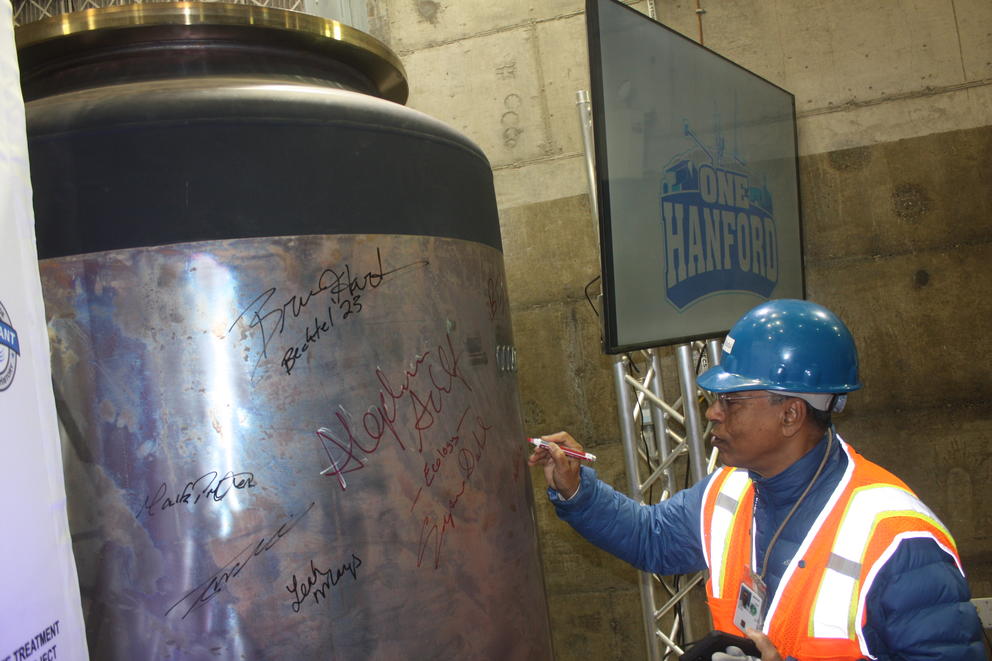The plan will be open to public comment at the end of May.
In the early 1990s, state and federal officials decided Hanford tank waste should be mixed with glass flakes and melted together so the radioactive substances cannot escape for 10,000 years. The original $4 billion glassification plant was supposed to be ready by 2009 and the work completed by 2019. But both budgets and deadlines have been busted several times in recent decades.
Currently, Hanford’s legal target calls for glassifying all wastes by 2052. DOE has internally moved those targets back to 2069, according to a 2021 report by the Government Accountability Office. That date was not reflected in Monday’s announcement, but those deadlines could be changed in the future.
“This agreement will get more tank waste retrieved, treated, and disposed of on schedule and gives us a roadmap for Hanford cleanup through 2040 and beyond,” said Laura Watson, director of Washington’s Department of Ecology, in a news release Monday.
Brian Vance, Hanford’s U.S. Department of Energy manager, said in the same release: “We have alignment on a plan that lays out a realistic and achievable path forward for Hanford’s tank waste mission.” DOE, Ecology and the U.S. Environmental Protection Agency signed a pact in 1989 to govern Hanford’s cleanup. This agreement has been modified several times, with Monday’s announcement being the latest. The four years of talks were also prompted by a federal judge’s order that the three organizations needed to revamp the cleanup schedule.
These are just proposed changes. A 60-day public comment period begins May 30, which could lead to further modification. Then a federal judge has to rule on the changes.
The Tri-City Development Council is studying the details of the tentative agreement before commenting on it, said David Reeploeg, TRIDEC's vice president for government programs. He noted that DOE, Ecology and EPA have not always been on the same page regarding how to approach Hanford's cleanup. With the tentative agreement, all three agencies now appear to be aligned on their approaches, Reeploeg said
The U.S. government set up Hanford in 1943 to create plutonium for the nation’s atomic bombs, including those exploded in New Mexico and over Nagasaki in 1945. That development work created many billions of gallons of chemical and radioactive wastes, the worst 56 million gallons of which were pumped into 177 underground tanks. About a third of those tanks leak. At least a million gallons of radioactive liquid have leaked into the ground, seeping into the aquifer 200 feet below and then into the Columbia River, roughly seven miles away.
Over years of debate and timeline changes, the glassification project’s budget has grown from $4 billion to $17 billion, and is expected to expand to more than $30 billion. No budget figures have been calculated yet for the proposed changes unveiled Monday, said DOE spokesman Geoff Tyree.
The timeline for beginning glassification of low-active wastes remains the same, August 2025. Hanford is currently preparing melters within the first plant, testing them with non-radioactive materials.
The first low-activity-waste glassification plant is expected to handle only 40% to 50% of the low-activity wastes, depending on who is doing the estimating. That means it is likely another plant will need to be built, unless another solution takes its place. Meanwhile, glassification of high-level wastes is also expected to begin in the next decade, said state ecology department spokesman Ryan Miller.
Adding grouting to the solution list may help
The GAO has been gung-ho about grout. Since 2017, the GAO issued three reports strongly recommending that the DOE look at replacing the second low-activity-waste glassification plant with a plan to grout the roughly 50 percent of low-activity wastes not handled by the first low-activity plant. Grouting is theoretically faster and cheaper than glassification.
Washington officials have always been skeptical about grout, citing its lack of a track record with the types of wastes found in Hanford’s tanks. DOE has been close-mouthed in the past about its preferences.
Monday’s tentative agreement calls for grouting to be used on low-activity wastes found in 22 tanks that also contain high-level wastes. A decision on grouting technology — which will then lead to budgeting and scheduling — is due by the end of this year.
Meanwhile, all 149 single-shell tanks and the majority of the 28 double-shell tanks are way past their design lives. So far, only one double-shell tank has sprung a leak in its inner wall, and thus can no longer be used.
The 2021 GAO report said DOE believes there is a 95% chance that Hanford will run out of space in its 27 remaining double-shell tanks before the next steps happen. If leaks occur in more double-shell tanks, that could delay glassification by several years and create further problems. It would take seven years and $1.5 billion to build four million-gallon double-shell tanks, the GAO reported. Since 2018, the Hanford Advisory Board has been pushing DOE to get started on this contingency plan.
Monday’s announcement calls for Hanford to add 1 million gallons in tank space by 2040. It has not been decided yet whether that will be one big tank or a group of smaller tanks.
There are also calls to revamp some of the piping system that sends waste from the tanks to the glassification plants, and to redesign the approach for processing wastes before they enter the future high-level waste-glassification facility.





